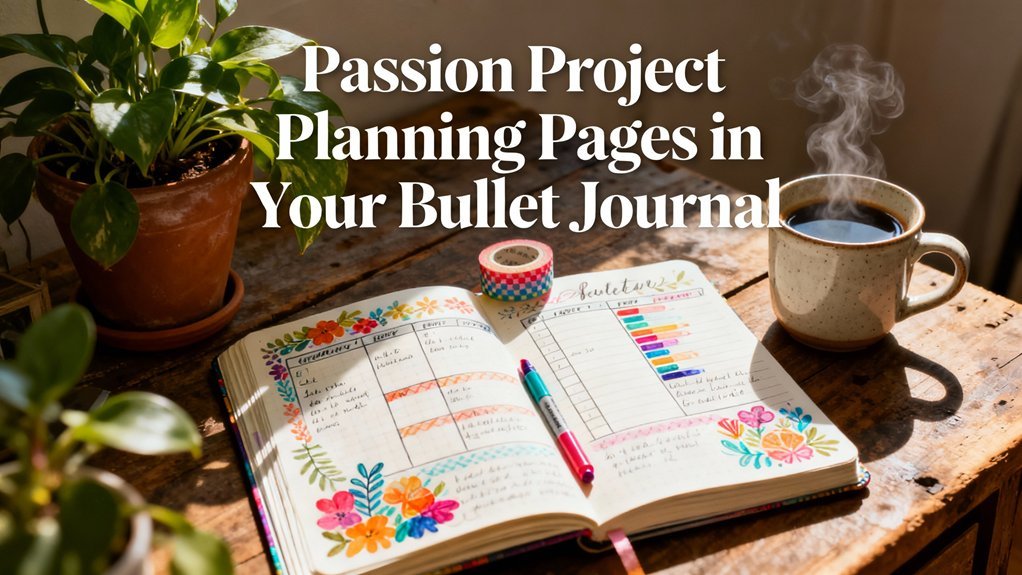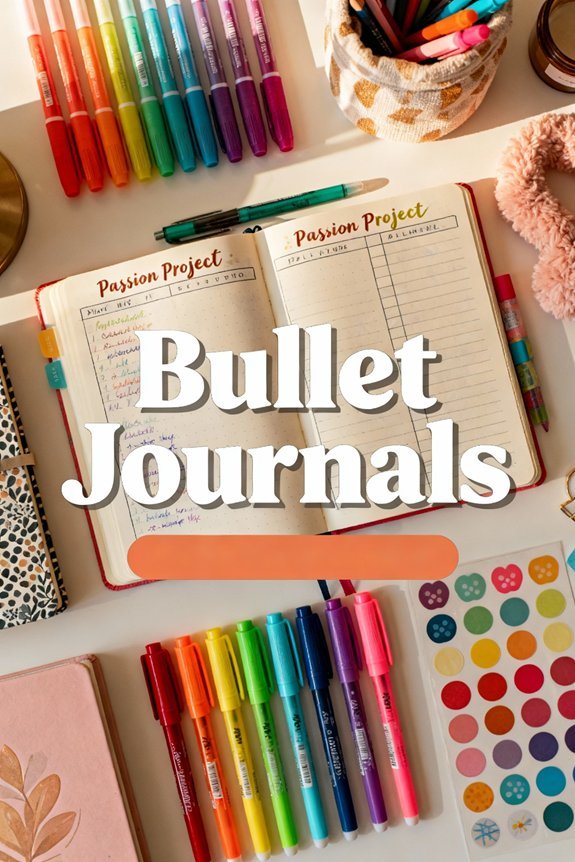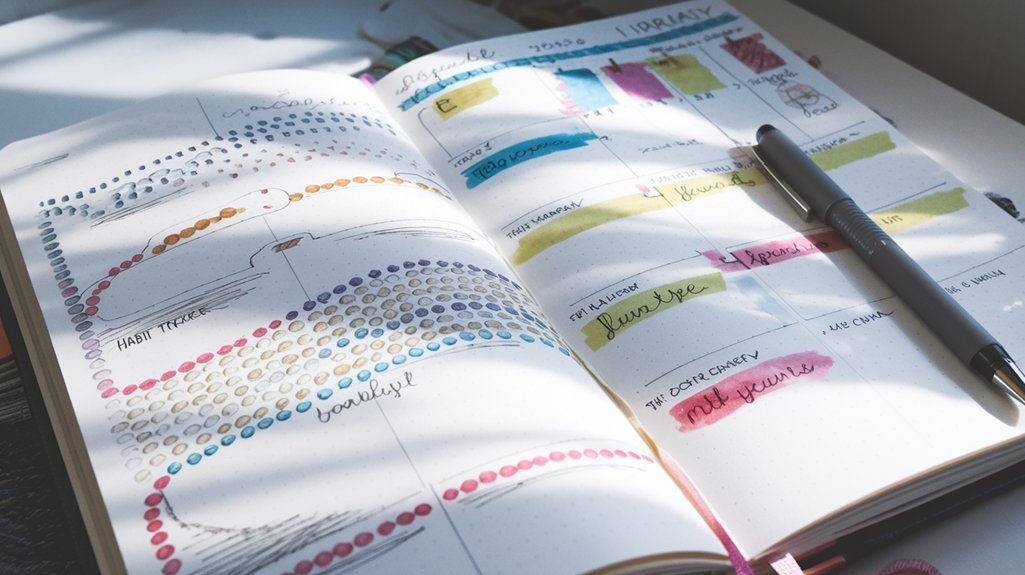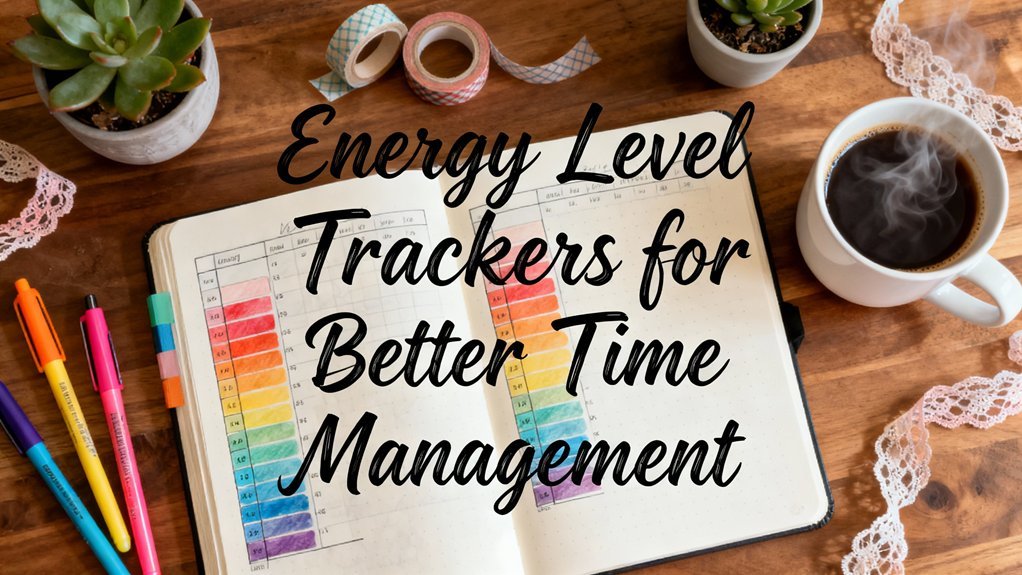Create a dedicated passion project section in your bullet journal by starting with a clear vision statement and breaking your big goal into quarterly milestones with specific deadlines. Include a resource tracker for materials and budget, weekly check-in pages to monitor progress, and a celebration section where you'll visually mark achievements with custom icons or progress bars. This centralized space converts vague ideas into actionable plans while preventing momentum loss. The strategies below will help you design layouts that match your specific project type and keep you consistently moving forward.
Key Takeaways
- Create dedicated pages with vision statements, milestone breakdowns, resource trackers, and reflection sections to transform ideas into actionable plans.
- Design custom layouts matching your project type: writing spreads, fitness logs, language vocabulary banks, business flowcharts, or art timelines.
- Implement visual progress tracking through habit trackers, milestone markers, color-coding systems, and progress bars to maintain momentum.
- Establish weekly check-in spreads to review completed milestones, identify obstacles, and prioritize three high-impact tasks for the week ahead.
- Break big visions into quarterly goals and micro-tasks using strategic milestone mapping, reverse-engineering from your ultimate desired outcome.
Why Passion Projects Need Their Own Dedicated Space
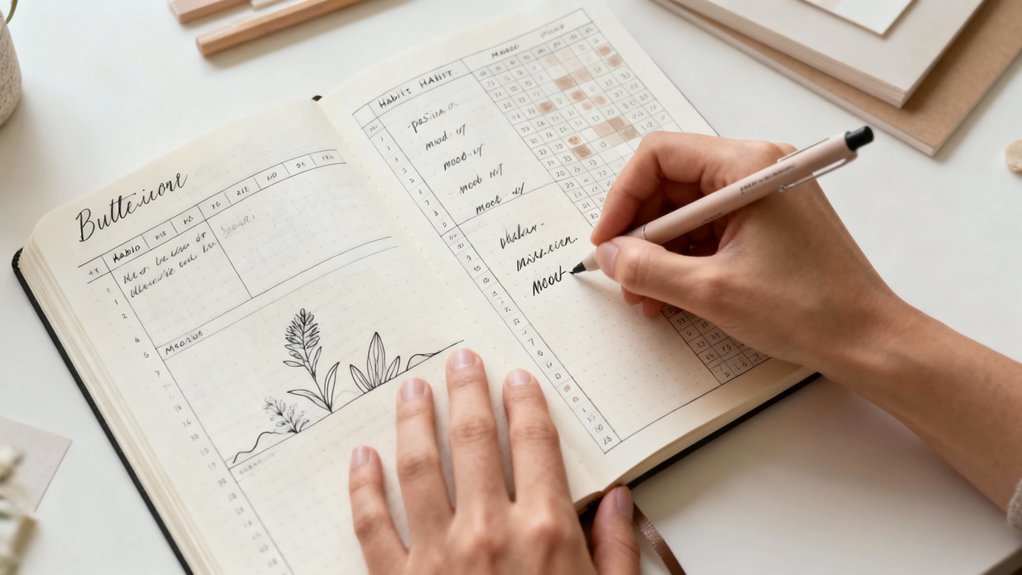
When passion projects compete for attention alongside grocery lists and meeting notes, they rarely survive past the initial spark of inspiration. You need dedicated space where your creative ambitions can breathe and evolve without getting buried under daily tasks.
A designated section in your bullet journal alters vague ideas into tangible action plans. You'll track milestones, sketch concepts, and document progress without flipping through scattered pages or losing momentum. This dedicated space becomes your project's command center—everything lives in one accessible location.
Creating distinct pages signals commitment to yourself. You're declaring this matters enough to warrant its own territory. Your project inspiration deserves visibility, not relegation to random margins or forgotten notebook corners.
Dedicated pages transform vague intentions into declarations of commitment—your creative work claims its rightful space instead of hiding in margins.
Visual boundaries help your brain shift from operational mode to creative mode. When you open to your passion project pages, you're entering a different mental space—one designed specifically for innovation, experimentation, and building something meaningful beyond routine obligations. Combining time management and productivity techniques within your dedicated project pages ensures your creative ambitions receive the structured attention they need to flourish.
Essential Elements Every Passion Project Spread Should Include
Your passion project spread changes from wishful thinking into a functional workspace when you include four core elements: a clear vision statement, actionable milestones, a resource tracker, and a reflection section.
Start with a vision statement that captures your passion project's purpose in one compelling sentence. This anchors your creative inspiration when momentum wanes.
Next, break your project into measurable milestones with realistic deadlines. This converts abstract ideas into concrete achievements while supporting effective time management.
Your resource tracker centralizes everything you'll need: materials, budget allocations, skill requirements, and reference links. No more hunting through scattered notes when you're ready to execute.
Finally, dedicate space for reflection entries. Document what's working, what isn't, and emerging insights. This creates a feedback loop that refines your approach.
The Bullet Journal Method helps you slow down and clear mental clutter as you work through these planning elements, allowing you to reconnect with what truly matters in your creative endeavors.
These elements work together systematically, ensuring your passion project evolves from concept to completion while maintaining the flexibility to adapt as you discover new directions.
Layout Ideas for Different Types of Passion Projects

Each passion project demands its own spatial logic—a fitness journey thrives with progress charts and habit trackers, while a novel-in-progress needs character maps and scene timelines. Consider these layout examples organized by project categories:
| Project Category | Optimal Layout Components |
|---|---|
| Creative Writing | Scene breakdown grids, character relationship webs, manuscript milestone tracker |
| Fitness Goals | Body measurement logs, workout split calendars, progress photo placement boxes |
| Language Learning | Vocabulary banks, conjugation tables, immersion hour counters |
| Business Launch | Revenue projections, client pipeline flowcharts, launch phase checklists |
| Art Portfolio | Technique experimentation grids, color palette swatches, exhibition deadline timelines |
Match your spread's architecture to your project's rhythm. Writing projects need narrative flow visualization, while physical pursuits demand quantifiable metrics. Design modules that adapt as your passion evolves—flexible frameworks outperform rigid templates. Your layout should illuminate patterns, reveal bottlenecks, and celebrate micro-wins within your larger vision.
Creating Milestones and Breaking Down Your Big Vision
Big visions paralyze without structure—the gap between “write a novel” and typing page one feels insurmountable until you architect the journey.
Change your passion project through strategic milestone mapping. Start with vision boarding: sketch your end result, then reverse-engineer backwards. What's your 80% completion point? Your halfway marker? These become your major milestones.
Next, apply quarterly goal setting. Assign each milestone to a three-month block, creating urgency without overwhelm. Within each quarter, identify 3-5 concrete deliverables.
Design your breakdown page with visual hierarchy:
- Top section: ultimate vision (sketch or write)
- Middle tier: 4-6 major milestones with target dates
- Bottom grid: monthly micro-goals
Use color coding to distinguish phases. Add progress trackers—circles to fill, bars to shade, or checkboxes to mark. This visual system changes abstract dreams into tangible waypoints.
You're not just planning anymore; you're building momentum through intentional architecture.
Tracking Progress and Celebrating Small Wins

Once you've broken your passion project into milestones, you'll need a system to monitor your momentum and acknowledge your achievements.
Visual tracking methods—like progress bars, checklists, or habit trackers—transform abstract goals into concrete evidence of your advancement.
Visual Progress Tracking Methods
Why do some passion projects fizzle out while others thrive? Visual tracking converts abstract goals into tangible momentum. You'll maintain motivation when you see concrete evidence of your progress unfolding across your pages.
Design progress charts that match your project's unique rhythm. Try habit trackers with color-coded cells, milestone timelines with illustrated checkpoints, or percentage bars that fill as you advance. Thermometer-style trackers work brilliantly for fundraising goals, while circular progress wheels suit cyclical creative projects.
Experiment with modular layouts that adapt as your project evolves. Stack mini-trackers for multi-phase initiatives, or create expandable grids that grow with your ambitions.
Visual tracking isn't just documentation—it's your innovation engine, revealing patterns and propelling you forward when enthusiasm wavers.
Milestone Markers and Rewards
While tracking progress measures your forward motion, milestone markers change that data into celebration opportunities.
You'll design visual indicators that highlight milestone significance—whether it's completing your first draft, reaching 50% completion, or mastering a new technique. Create dedicated spaces where you'll mark these achievements with stamps, stickers, or colored borders that make your accomplishments impossible to ignore.
Effective reward systems convert abstract goals into tangible motivation.
You'll link specific milestones to predetermined rewards: a favorite meal after finishing a chapter, new supplies at the halfway point, or a weekend retreat upon completion. Document these reward commitments directly on your planning pages, creating accountability contracts with yourself.
This approach maintains momentum during challenging phases while ensuring you're consistently acknowledging your dedication and progress.
Reflecting on Achieved Goals
After you've crossed the finish line on a goal, reflection pages change that achievement from a checkmark into meaningful insight.
This dedicated space alters reflective journaling into actionable intelligence for future projects.
Design your reflection spread to capture:
- Visual documentation – Include photos, sketches, or goal visualization elements that chronicle your journey from conception to completion.
- Lesson extraction – Identify what worked, what didn't, and which strategies you'll replicate or abandon next time.
- Evolution tracking – Compare your initial vision against the final outcome to understand how your project evolved.
Create modular sections you can customize based on project type.
Use color-coding to link reflections back to original planning pages, establishing pattern recognition across multiple passion projects and accelerating your creative development process.
Keeping Your Passion Project Momentum Going Strong

Your passion project needs consistent attention to maintain momentum, and weekly check-in spreads provide the structure to keep you accountable.
These dedicated pages let you review what you've accomplished, identify roadblocks, and set intentions for the week ahead.
Weekly Check-In Spreads
One weekly check-in spread changes scattered project thoughts into tangible progress. You'll reshape vague intentions into documented momentum by dedicating a single page to weekly reflections each Sunday or Monday.
This systematic approach reveals patterns in your workflow and highlights where project adjustments are necessary.
Structure your spread around three core elements:
- Progress metrics – Track measurable milestones you've completed versus what you'd planned
- Roadblock analysis – Identify specific obstacles preventing forward movement and brainstorm solutions
- Next-week priorities – Select three high-impact tasks that'll advance your project meaningfully
Design your layout to accommodate quick scanning—use color coding, progress bars, or checkboxes that match your visual preferences.
You're creating a living document that evolves with your project's needs, not a rigid template that constrains your creative process.
Celebrating Small Wins
Each completed task—no matter how minor—deserves intentional recognition in your bullet journal. Design a dedicated section that changes small achievements into visual momentum builders.
Create custom icons, progress bars, or milestone markers that track your wins with precision. You'll maintain forward motion by documenting positive reinforcement moments—finishing research, completing a prototype iteration, or mastering a new skill.
Consider implementing a color-coding system where different hues represent achievement categories, making your progress immediately scannable.
Structure your celebration spread with these elements: date stamps, specific accomplishment descriptions, and emotional impact notes. This systematic approach converts abstract progress into concrete evidence of your project's evolution.
When motivation wanes, you'll have documented proof that you're advancing, encouraging continued innovation and commitment.
Frequently Asked Questions
How Do I Choose Which Passion Project to Focus on First?
Start by evaluating each project against your personal goals and available resources.
Create a visual matrix in your journal comparing time commitment, skill requirements, and potential impact.
You'll want to customize your project evaluation with criteria that matter most to you—whether that's learning opportunities, creative fulfillment, or tangible outcomes.
Through strategic goal setting, you can identify which passion project aligns best with your current capacity and generates the most excitement for innovation.
What if My Passion Project Changes Direction After I've Planned It?
That's completely natural—embrace it!
Adopt a flexibility mindset by viewing your bullet journal as a living document, not a rigid contract. When your project shifts, simply create fresh planning pages that reflect your new direction. You're adapting goals, not abandoning them.
Use visual markers like color coding to track evolution, add modular spreads for emerging ideas, and customize layouts as you discover what works.
Innovation thrives on iteration, so let your pages evolve alongside your vision.
How Much Time Should I Realistically Dedicate to My Passion Project Weekly?
Start with 2-4 hours weekly, then scale based on your project evaluation results.
Create a visual time-tracking spread to identify patterns—you'll discover your ideal rhythm through experimentation. Use color-coded blocks to map energy levels against project phases.
Strong time management means being flexible; your bullet journal becomes a fluid dashboard showing what's actually working.
Test different schedules monthly, adjusting as you gather real data about your productivity and creative flow.
Can I Combine Multiple Related Passion Projects Into One Spread?
Think of your spread as a constellation connecting creative stars.
You'll improve creative organization by grouping related project themes together—perhaps photography and graphic design, or writing and podcasting.
Use color-coding, sectioned layouts, or interconnected trackers to distinguish each initiative while showing their relationships.
This approach lets you visualize synergies, share resources efficiently, and maintain momentum across ventures.
Your customizable system becomes an energetic dashboard that celebrates how your passions naturally complement each other.
What Supplies Work Best for Creating Passion Project Pages?
You'll want versatile supplies selection that adapts to your vision. Fine-liners, brush pens, and highlighters form your core toolkit, while washi tape and sticky notes add flexibility.
Your creative tools should improve functionality—try dot grid paper for precise layouts, transparent rulers for clean lines, and colorful markers for visual hierarchy.
Don't overcomplicate it; choose supplies that spark innovation while keeping your pages practical. Test different combinations to discover what raises your unique planning style.
Conclusion
You've mapped out your vision, designed your spreads, and set your milestones. But here's what'll determine success: what you do tomorrow morning. Will you open that journal? Will you fill in one tiny square? Your passion project pages aren't just pretty layouts—they're your accountability partners, waiting. They'll adapt as you evolve, celebrate when you progress, and remind you why you started. Now close this tab and make your first mark.

